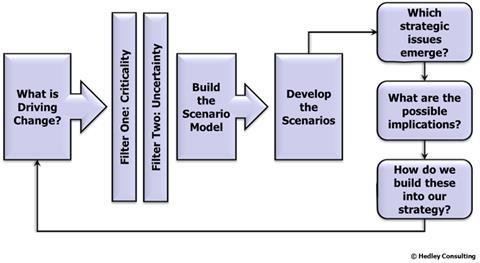The one thing that seems certain in the legal sector is uncertainty. So how can law firm leaders ensure their firms are fit for the future, when they don’t know what that future might be? Andrew Hedley offers a practical approach

The futurologist Alvin Toffler coined the phrase “future shock” in his 1970 book of the same name, to describe the psychological phenomenon of individuals and societies experiencing “too much change in too short a period of time”.
His predictions of the impact of accelerating change will resonate with many in the legal profession, as upheaval and instability increase, and it becomes ever more difficult to predict what will happen next. The two things that we can assume are that the pace of change will continue to quicken, and that uncertainty will be an enduring feature of the legal services market. The question is, what can law firm leaders do in order to be fit for the future?
How do we know what to plan for?
The ‘old world’, in which one had a high level of confidence that this year would look broadly like last year, and where we could reliably plan on that basis, is gone.
For the tens of thousands of lawyers practising in the UK (and those who will enter the profession over the next few years), law no longer guarantees, if not untold riches, at least a comfortable, middle-class existence. Yes, some will still have stellar careers and find fame within the profession, but they will be a mere handful when viewed in the context of the whole.
For the rest, especially those in undifferentiated firms or practice areas – with supply far outstripping demand and where the impact of technology is profound, the challenges of attracting and retaining talent are significant, clients are increasingly sophisticated and demanding, and inter-firm competition is intense – success will flow from good business practices rather than any skills learnt in law school.
Law firm leaders must grapple with these challenges now by devising and implementing strategies to ensure that their firms are sustainably profitable, adaptable and resilient.

In order to develop plans to future-proof your firm, you would imagine the first step is to build a good understanding of what the future may look like from a number of perspectives – that of the client, the lawyer, the owner, the leader – and how these may impact on the business, operationally, tactically and strategically.
However, coming to such a long-term view is very difficult in a sector where industry-disruptive events occur with increasing frequency and ever further-reaching consequences.
This challenge is compounded by the fact that these huge changes are not confined to just one sphere of operations. Taken in isolation, the disruption wrought by any one of a number of key developments – deregulation, technology, shifting societal norms and expectations – is significant. However, taken together, they have a multiplier effect and create a business environment in which the need to do things differently (rather than simply striving to do what we have always done better) is necessary not only for success, but also for survival.
Factor in the uncertainty surrounding Brexit, with the apparently increasing possibility of a disorderly ‘no-deal’ departure from the EU, and we have all of the features of a perfect storm.
In light of all this uncertainty, what actions can law firm leaders take to increase resilience and create a more robust platform?
1. Focus on core competencies
Start by focusing on the basics and building the core competencies that will be needed for future success.
Imagine you are the manager of a sports team. You’ve been approached about a completely new sport that is being created, and asked to put together a team and prepare for the first match, taking place in six months. The only problem is that nobody has written the rules of the game yet. All that you know is that it will be played between two teams of players, will involve a ball, and will take place on a piece of grass. You are also told that the rules of the game will only be available in five months, one month before the first competitive fixture. What do you do?
One option is to wait for the certainty of the rules and then, in that final month, decide the composition of the perfect team, go and find those players, and get them training hard to be ready for action. But the risks of this approach are obvious. Will the players be available? Can you get them in the timeframe? Will they have enough time to gel as a team?
What are the skills that we know we will need to succeed in the future?
Alternatively, we could start with what we know to be true using the facts at our disposal: two teams, a ball, and a piece of grass. We know there will be certain skills that we will need to succeed. These ‘core competencies’ might include, for example, speed, stamina, hand-eye coordination, agility, communication and team spirit. You could choose to work on these skills with your existing team for the five months before you know the rules of the game, and once they are revealed, you could then adapt these ‘core competencies’ to the specifics of the game in hand.
How might this ‘core competencies’ approach be applied to the legal industry? What are the skills that we know we will need to succeed in the future? These may include ‘hard skills’ like the use of technology, project management capability or financial management. There will also be relationship skills, such as team motivation, client development and communication. Of course, there are also core legal technical disciplines which cannot be ignored, but these are the baseline requirement, rather than the things that will make a material difference in driving future success; they are necessary but not sufficient.
Work with your leadership team and managers to define the core competencies for your people. Add to this intelligence from client feedback and current awareness about the industry. Now consider how to support the development of those – training may be your go-to solution, but also think about mentoring (and not necessarily top-down, as your junior members may be more experienced and knowledgeable around, say, technology) or business coaching.
A focus on core competencies gives clarity of direction and purpose. It is actionable and provides tangible benefits on a timescale that is under the control of the management team.
2. Build in flexibility in your cost base
The cost base of the traditional firm is inherently inflexible: most costs are either fixed or semi-fixed. This raises challenges for management; once costs are covered, profit flows freely, but until this happens, losses can be crippling and are largely unavoidable. So how can leaders build more flexibility into the cost base?
People and property are the two most significant costs, and are clearly intertwined in the traditional, linear, ‘do things the way we’ve always done them’ model: more work means more people, which means more space. Such decisions are predicated on assumptions including the following.
- Every person needs a desk, even if it is only occupied for 75% of the week.
- We want people where we can see them, because that way we know what they’re up to (in other words, we don’t trust our people).
- We need people on our payroll, not sourced through a flexible resourcing model.
- Technology could probably reduce our headcount requirements, but that would be a very difficult process to manage, with a less-than-certain outcome, so we will avoid making that difficult decision.
But flexible working can reduce costs and increase a firm’s agility, and thereby its ability to respond to changing market conditions and compete effectively in the future.
Of course, the nature of fixed costs is that they take time to change, but there are a number of incremental changes that firms can make which will improve flexibility. For example, could an agile working approach be introduced that frees up space which would then be available to sub-let? Rather than recruiting to fill a vacant role, could the work be done differently, or could a flexible resourcing provider create a more open-ended resourcing model? Attitudinally, how prepared are you to challenge historic working practices and create new ways of working which improve productivity? The pressure of challenging market conditions can provide an excellent catalyst to grasp some of these working-practice nettles.
As a profession, we also need to become much more comfortable with managing risk in seeking an improved operating model. Being 90% right, and fast, wins every time in a fast-changing world. Although the risk in the 10% of uncertainty must be managed, it’s better than aiming for 100% right: it only rarely exists and, even then, will be transient, as the environment develops. Law firm leaders must make a conscious trade-off between speed of action and the pursuit of perfection.
3. Understand and plan for potential changes
Although, as I said above, the one certainty in the legal sector is uncertainty, many law firms still build their strategies and business plans as if they know the future. They envisage a known start point and a desired end state, with a series of predetermined steps in between. An acid test of the strength of any strategy is the way in which it is able to accommodate and respond to uncertainty and unforeseen risks as they emerge over time.
So how can you develop a more effective strategy for your business?
Scenario-planning techniques are a great start. Modelling of this kind combines known facts about the market, the firm and its competition with a number of plausible future developments that would change the market significantly. This approach can increase law firm leaders’ understanding of business uncertainties and help you map out responses (whether they be defensive or taking advantage of an unfolding opportunity) to a range of circumstances affecting both the firm and its clients. The approach is shown in figure 1 (below).

Start by building a clear understanding of the factors that are driving uncertainty in your firm’s markets and wider economic environment. What are the factors which are apparent in your markets, yet about which you have little understanding and over which even less control?
Next, consider each of these drivers in two ways:
- How critical is it – how significantly could it change the competitive environment in a way that impacts your firm’s strategy?
- How plausible is it?
However, plausibility should not be confused with predictability or probability! Events which are predictable or probable should have already been factored into strategic thinking at an earlier stage.
We are concerned here with those things which fall outside the norms of thinking. The next step is to create different permutations, and turn them into a series of possible futures against which the firm’s strategy can be tested. While you could select any driver, you may want to focus on those which are both critical and plausible, as these are likely to be of most concern.
This will result in a number of scenarios. Use these to build theoretical solutions or approaches to mitigate risk. You are looking for approaches which will allow you to respond at speed, in a way which minimises any downsides, while seeking to gain advantage from new opportunities that are unearthed.
For scenario planning to be effective, you need to build two things:
- a comprehensive, unambiguous understanding of the strategic issues which emerge
- a clear, viable picture of the possible implications of these issues for the firm and its strategic direction of travel.
Only then can discussions be entered into, and decisions made, about how the current strategy may need to be adjusted (or even fundamentally changed) as a result of the facts which have been unearthed and modelled.
With scenario-based thinking mastered, and skills embedded within the firm, the technique can then be used as a powerful aide to business development. Engaging commercial clients, perhaps in a workshop setting, in a scenario-planning exercise about their own businesses can be hugely powerful. It is a great way to show clients that you are working to understand their sectors, their business situation and the key competitive forces at play for them. You can also learn from the exercise about how you could help clients to manage their business risks and explore their growth opportunities.
The number of firms adopting a scenario-based view in their strategy formulation and resource planning remains surprisingly small. For those already using these techniques, the advantages are clear. For those not yet convinced of the benefits, it is to be hoped that the intellectual argument can be won before a high-impact scenario – which could have been anticipated and planned for – unfolds to their detriment.
4. Manage change effectively internally
For many firms, the most significant challenges to securing a sustainable future lie within rather than outside the organisation. These will commonly include constitutional, governance, succession, culture and management timebombs, which are ticking but are either ignored or tampered with superficially on an infrequent basis.
Many law firms will recognise the need for effective change management when they are making a planned-for change, such as a merger or structural change. But change management is also essential when planning for uncertainty.
It is likely that cultural shifts will be necessary to effect many of the changes discussed above. For instance, when you are looking at identifying and developing the key competencies discussed earlier, consider the following questions.
- How will you recognise and reward the development and use of these skills through your appraisal process, and promotion / partnership track?
- How will you change your recruitment processes to identify these skills in new recruits?
- How will you embed this cultural change in your induction processes?
I have written about change management and culture in two previous articles in Managing for Success, ‘Changing with the times’ (April 2017) and ‘Culture club’ (October 2017), both available from the Law Management Section website.
5. Make things happen
Imagine you are sitting looking at the horizon. The sun is perched on the edge, ringed by orange and red. But how do you know if it’s rising or setting? What happens next, whether the disc diminishes or grows, tells us at what point of the cycle we are.
This is the situation law firms now find themselves in. Where in the cycle of change do you position your business?
The answer to this question varies from firm to firm and, while it is shaped by specific market circumstances, it is most importantly predicated on the vision and leadership qualities of the partner group.
More than at any time in history, making active choices about where to build, where to maintain and where to withdraw will be crucial. For the firm to succeed, the management team must be flexible and adaptive in the face of ever-quickening changes in both the external and internal environment.
When you are trying to reduce uncertainty, the answer will often be to simplify rather than to complicate. Clarity of direction, strategy, purpose and communication all flow from a simpler and more coherent view of the firm’s future position.
As leaders, we should be under no illusion: firms will not become fit for the future through reflecting, analysing and planning. Only strong leadership, driving changes across all areas of the business, will deliver the metamorphosis that is required.
In the final reckoning, there are three types of firm: those that make things happen, those that watch things happen, and those that wonder what happened. It is the job of the leader to ensure that you are in the first category and not the last.
















